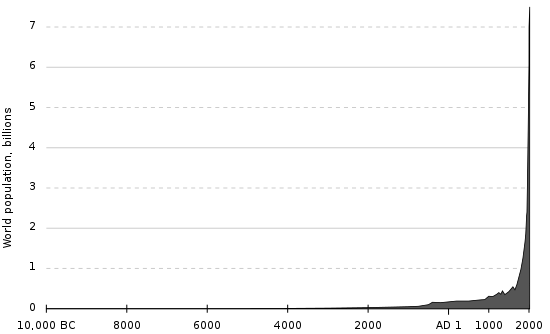We are now living in a time where 2% annual growth in GDP seems nothing more than normal. In emerging economies like China, an annual growth rate of 7% (or even up to two-digit in earlier years) almost becomes the norm. But where does the economic growth come from? Where does it start? How does it grow and where will it go? We will try to have a glance of these questions in this post.
The History of Growth
If we look at the chart of global economic growth in terms of GDP in a larger scale – like dating back to B.C., we will find that the graph actually looks like a “L” in mirror: for a very long period of time before 18th century, the line is generally flat; however, once the history enters 18th century, the exponential growth of economy starts. The turning point is obvious: the industrial revolution. Before the industrial revolution, for a very long period of time in human history, the economic growth was mainly driven by the increase of population as the productivity increased in a very slow manner. Even the population did not grow in a rapid speed because of the low birth rate and high mortality rate. As a result the economic growth was constrained by the total population.

“The Growth of Growth”
But the boost in technology, mainly recognised as industrial revolution, makes things different. The technology changes from better machinery and equipments, accumulation of knowledge and better management and organization allow more output with the same amount of capital input. Even if we do not consider the boom of population as shown on the prior chart and simply measure the productivity using GDP per capita – the advancement in technology finally results in the growth of productivity growth rate, “the growth of growth”.

So how significant is the different between a 0.2% and 2% annual growth rate? One intuitive way to understand it is to use The Rule 0f 72: dividing 72 by the growth rate you will get the number of years required to double the original amount. When the annual growth rate is 0.2%, it takes 72/0.2 = 360 years to double the GDP per capita; while if the annual growth rate is 2.3%, it takes only 72/2.3 = 31 years to double. This is the magic of compounding: a small change in compound rate can makes a big difference in the long run. Don’t forget this is only the growth rate of GDP per capita. Combining this “growth of the growth” and the population expansion, the effect will be amplified and will lead to exponential growth of the economy.
Lessons
The long-run real growth of economy eventually relies on the improvement on productivity, which requires technology progress. The society keeps innovating and leveraging on existing knowledge to invent new technology and to increase human’s ability to turning more and more resources into products. Where is the future of the growth? Now we do see lots of opportunities from the emergence of new technologies, like Artificial Intelligence, Robots and Virtual Reality; however, we also face an increasing number of challenges in attaining the growth: pollution, constrain on resources, and the sustainability issue. So here is the lesson: don’t take the economic growth for granted. No economy is growing 2% in real terms
“naturally”. Behind the growth rate are tens of thousands of people testing new prototypes, proving new theories and refining management. The real driver of economy should always be new technology. Those who contribute to the technology will be rewarded significantly by the economy – check the Forbes Billionaires List, Bill Gates or Larry Ellison did not gain their wealth simply as a “businessman”.
And the final lesson: despite the short-run fluctuation of economic growth, in the long run we shall still be optimistic about our economy. Next time when things go wrong, calm down and think twice: things may not be as worse as you see.



